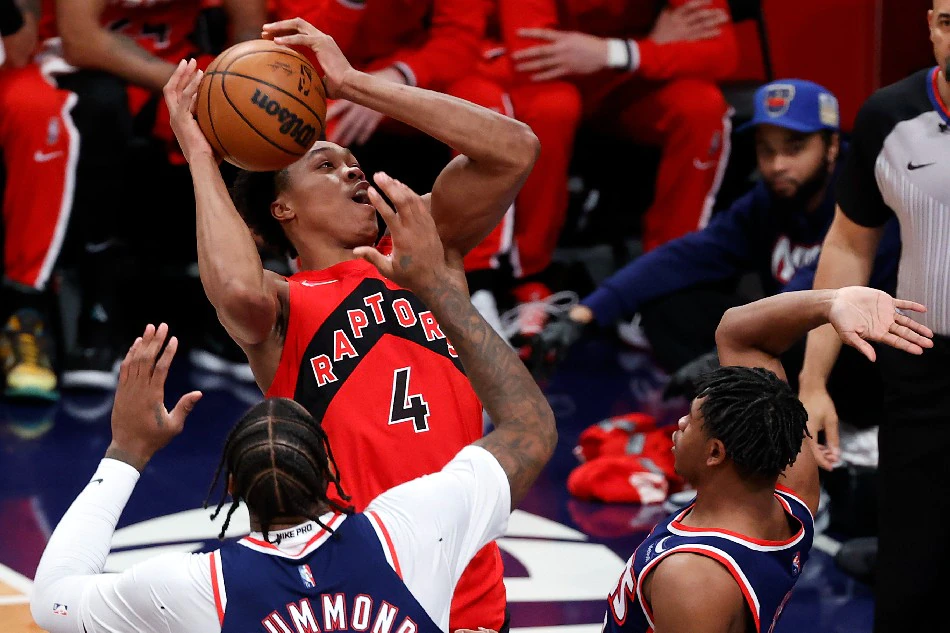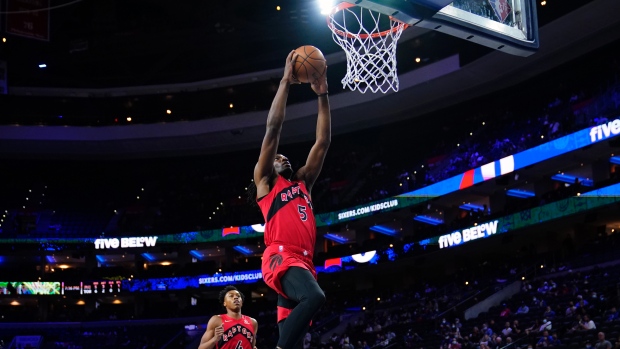It happened in the second quarter. Scottie Barnes sprinted in transition, trusting his legs to create an advantage over whatever ground-bound behemoth might have the misfortune of guarding him. He drew a crowd, allowing Pascal Siakam to eventually receive the ball in the post against a mismatch. Barnes wasn’t done running around though, and after clearing the lane he sprinted back into it. Siakam found him, and the Nets swarmed into the middle of the lane. Yuta Watanabe, not to be outdone by Barnes’ off-ball hustle, sprinted into the space that Barnes had just vacated, received the pass, and tossed in the layup.
The play showed the value of effort and smarts being more than the sum of their parts. Having one player run hard opens up advantages elsewhere. Having multiple players run hard allows a team to convert on those advantages. Barnes cutting and clearing and cutting some more created oodles of empty space that Watanabe was able to drift into. Good cutters don’t just find empty space; they also create it. Which allows other good cutters to find that new space, etcetera and ad nauseum, creating a vicious cycle of whirlwind activity that only ends in easy points and frustrated opponents.
That same lineup included Thad Young, who continues to prove he was built to play on this team. The Raptors used that lineup to stack cutting on top of cutting. That skill, like shooting, can have cascading effects. Quick decisions, off-ball movement, and visionary passing functioned as the severing blade in Golden State a few years ago when Draymond Green revolutionized NBA offense. Steph Curry, of course, and his shooting prowess functioned as the stanchion that held defenses in place (increasingly, further and further away from the rim) for the blade to strike. Together, they combined into a guillotine.
Young, Watanabe, and Barnes’ cutting functioned as a miniature guillotine against the Brooklyn Nets.
Toronto’s bench problem thus far this season hasn’t been a lack of scoring, or at least the lack of scoring has been more a symptom of the problem than the cause of it. The problem has been a lack of plus skill-sets being applied to the game. Scoring is the most obvious skill that allows players to impact the game, but it’s not the only one. Other skills are less self-evident, more dependent on context and situation to be impactful. Watanabe’s cutting, for example, is only useful when others on the floor create space for him to actually cut into.
The Raptors found a way to make their bench skills impact the court. They say “there’s only one ball” as an insult to players who all thrive when holding it. But what’s the saying for a wave of players, none of whom need the ball? That’s what Toronto’s bench seems to be. Multiplicative, not subtractive. That’s hard to make work when the skills don’t slot in neatly, thoughtlessly. But it’s feasible.
The effort against Brooklyn is replicable, but it’s not going to be easy. It requires lineup contortion and philosophical adaptation.
One major component was the performance of Malachi Flynn. He controlled the game from top to bottom and finished with 18 points and five assists as well as a team-high (by a huge margin) plus-minus of +42. He hasn’t had the chance to run a game yet this season, and he didn’t disappoint in this one. He hit his triples, darted into the lane and sprayed passes, controlled the pace, ran in transition, and did just about everything to ensure the success of those around him. He hit the paint over and over until the Nets said uncle. That’s point guard stuff. For Toronto’s bench to be successful, it either requires Fred VanVleet to play 48 minutes (not possible), the no-point guard lineups to work consistently and for longer stretches (undetermined but improbably, even if they wreak havoc sometimes), or for Flynn to repeat this performance on smaller scales. Flynn combined with the bench cutters to become the guillotine that decapitated the Nets.
When I asked Nurse about the Young-Barnes-Watanabe trio all playing together — and this quote was intended to go in the beginning of the piece about Barnes and Watanabe cutting together — he gave real insight into not just the benefits of having so many cutters-as-primary-skill-guys on the bench but also the difficulties in making it work.
“Well, They gotta kind of play off each other, and they got to decide who’s gonna do what sometimes,” he explained. “They all can space it a bit. They all are probably better cutters than they are spacers, but they can’t all cut together. So it’s one of the things we talked about here this morning and walked through a little bit [and were] trying to get organized on who’s gonna stay out there and who’s gonna cut and who’s going to do some of that stuff. It’s good. I mean, listen, if they can get some chemistry and figure that out a little bit like they did tonight and then obviously they hit a bunch of shots, you know, they all threw some in too, right, Thad, Precious, Chris, Yuta, all those kind of bigger wings all threw in a couple threes too. So kind of [all] doing their secondary skill [at a] very, very high level tonight.”
Of course — and this should be obvious — it’s easy to make everything work when a) you’re playing a team without Kevin Durant or Kyrie Irving or Ben Simmons and b) everything you do works. Barnes, for example, tied the all-time record for most tip-ins in a single game with five. Thad Young made more threes in a single game than he has since February of 2020. Yuta Watanabe played the Anthony Edwards to Kessler Edwards’ Yuta Watanabe. (He dunked on him, if that’s too convoluted). Those things aren’t always going to happen. Yet the spirit of the contributions could remain.
Implicit in Nurse’s point is that cutting well doesn’t just happen like shooting does. Cutting requires coaching and chemistry and thoughtfulness. You can’t just roll out the ball and expect the type of players Toronto has on the bench to succeed like you could for a Jordan Clarkson-type scorer. You have to build an on-court environment and structure that fosters cutting. Part of that is making sure Toronto’s all-vibes, no-positions offense has just enough structure that players don’t all cut into the same space at the same time. Part of it is making sure what’s going on with the ball is threatening enough to unlock whatever’s going on away from the ball. Siakam now drawing two defenders — even on an off night — serves well to do that. Toronto’s bench players applying force to the offensive end requires work in the film room as much as the weight room.
You know what else helps give bench players energy? Energy they can use for cutting and running and doing bench vibe thangz? Playing in front of a crowd! It’s easy for stars to do star things no matter how many spectators are in the gym. It’s much harder for role players to toss in six points and three rebounds in eight minutes of game time without a roaring crowd to catalyze the pace. And the crowd is coming back to Scotiabank. The Raptors may have won a no-contest Monday game in February against a team missing its three best players, but they found a far more significant prize in the answers to a season-long problem: the Raptors may be learning how to use their bench.



